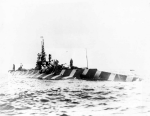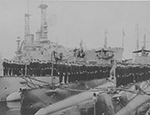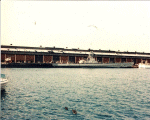NavSource Online: Submarine Photo Archive
| Click On Image For Full Size | Size | Image Description | Source | A Brief Pictorial History of Submarine Camouflage|
|---|---|---|---|---|
 |
100k | Portside view of the K-2 (SS-33) off Pensacola, Florida on 12 April, 1916, underway with "zebra" camoflouge. It seems a bit strange to discuss camouflage for submarines. After all, the very fact that submarines go beneath the water gives them an important measure of invisibility. But the submerged endurance of early submarines was quite limited. Most of the time they operated on the surface. In the era when underwater power was derived from electric storage batteries submarines had to conserve energy. Faster speeds meant that a submarine might have to return to the surface sooner and lose the cloak of invisibility that was so important for it to carry out operational missions. By the time submarines had proved themselves a formidable weapon in the First World War the problem of concealment while on the surface was already a major concern. Both German and British submarines received some form of deceptive or disruptive camouflage during that war. The United States also took an interest and conducted experiments in order to better protect her submarines from visual detection. One of the theories of perception that was examined in those experiments was that of American artist William Mackay. He postulated that a ship painted with blocks of various colors would appear to blend into background when seen from a distance. The 4th submarine division of the US Atlantic Fleet was chosen to see if there was any merit to the idea. In mid 1916 and 1917, before the US entered the war, the K class submarines were painted in various patterns and colors and observed under different conditions. In my collection of model warships I painted models to match their appearance during those trials. The rough drawings I prepared to show those patterns are illustrated here and here at a ratio of 1-1200. Some of the photographs used in preparing these drawings are available on Navsource. As a result of these trials the US Navy concluded that a simple overall light gray hull and black decks provided as good visual protection as any other method. Consequently, U S submarines were painted overall light gray with black paint on the decks and on the outer surface of the ballast tanks. Submarine visual camouflage became an issue again before the outbreak of the Second World War. This time the question was not only one of concealing a surfaced submarine, but also of hiding a submerged submarine from aerial observation. Once again, a series of trials was conducted to test various ideas. Tests between 1934 and 1936 were inconclusive. A new series was ordered and took place off Pearl Harbor in mid 1937. Four boats of the old "S" class were used. S-28 (SS-133) was painted entirely black, S-35 (SS-140) was dark blue-gray overall. S-21 (SS-126) was given a coat of dark purple. In a second series, disruptive patterns were used. S-21 carried black and green. S-35 was painted in black, blue and green. For a third, and final, test S-22 (SS-127) was given a pattern of dark blue and black. The conclusion reached from these experiments was that dark blue offered the best concealment in deep, clear, tropical waters. As a result, Commander SubRon 4 ordered boats of SubDiv 8 to be repainted in blue as paint became available. Paint for all navy ships was under the provence of the Bureau of Construction and Repair in the Navy Department and appropriate instructions were covered in the booklet issued by that Bureau known as C&R-4. Meanwhile, another series of tests were being conducted by Subron 6 off San Diego. For this series 4 new submarines were given new colors as follows: Perch (SS-176) overall light greenish gray, Pike (SS-173) black, Permit (SS-178) dark blue, as recommended from Pearl Harbor, and Porpoise (SS-172) a black hull with a light green-gray conning tower. This time, black was determined to be the best color, even better than the dark blue previously recommended. As might be expected, this resulted in orders for another test, off Panama, and using just the black and dark blue. The result was inconclusive because the blue paint deteriorated after application and acquired a lighter, 'milky', tone. Finally a decisive series of tests was scheduled off Key West in Feb 1940. Spearfish (SS-190) was painted black,and her sister Sculpin (SS-191) was painted dark blue. This test also resulted in controversy because the formula used for the blue paints in each test was not uniform. The final decision to use black paint exclusively had little to do with the results of these various experiments. The most important reason for the decision was the acknowledged superior durability of the black paint. The Bureau of Construction and Repair had become the Bureau of Ships and In January, 1941 the navy issued a new manual for camouflage painting. It was generally referred to as SHIPS-2, being the second major book issued by the Bureau of Ships. In it, various camouflage designs were assigned 'Measure' numbers. Overall black became camouflage Measure 9 and had actually been applied to all U S submarines by the end of 1940. Black did not keep its hegemony over submarine camouflage for long. By June, 1942, an alternative had been introduced. Measure 10 called for the use of Ocean Grey (5-O) instead of black for submarines operating in areas where reduced visibility from surface vessels was more important. Only a few submarines were repainted in Measure 10. At the beginning of 1944 another set of alternatives was available. The new measures, 32/3SS-B and 32/9SS were spelled out in supplement 2 to the Revised 2nd edition of BuShips-2, the instructions for the painting of naval vessels when it was issued in mid 1944. Both the new measures called for graded shading. Measure 32/3SS-B, commonly referred to as the 'light grey job', started out with light grey paint applied to vertical surfaces from the bow until abaft the conning tower. At that point it was blended into a medium grey. further aft the mediume grey, in turn, blended into dull black. Decks were overall gloss black. White countershading was perscribed for the undersides of gun platforms on the conning tower. Persicopes were to painted with splotches no smaller than 5 inches across in dark and light grey. Measure 32/9SS was very similar except that it started medium grey in place of light grey and blended into dark grey forward of the forward deck gun. It gave a much darker overall appearance and was therefore known as the 'dark grey job'. The solid black of Measure 9 slowly disappeared from use as submarines rotated home for overhauls which included a fresh coat of paint. Despite Bureau instructions there were always cases where patterns or colors were applied outside the range specified. Sometimes this was caused by a particular color not being available at the time the boat was painted. In other cases, the commander of the boat decided to make a change. One example of this behavior was Harder (SS-257). Her Measure 9 was replaced with a 'light grey job' in December, 1943. But her skipper became convinced that a touch of red would induce Purkinje effect and make his boat harder to see. When she left Australia in early 1944 her light grey was reported to have a decidedly pink appearance. For those paying close attention, notice that the "new" measures were already in use well before their official proclamation date in Ships-2. At this point it is worthwhile to mention that paints for submarines were formulated in a different manner than those used for other ships. One of the reasons, possibly, being that there was less space for stowage of paints on submarines. The chief reason, however, would appear to be the necessity for greater durability in submarine paints. Surface ships were given matt paints. They eroded rapidly when exposed to sea spray for extended periods. Various shades were created by adding tinting materials to base paints and mixing. On submarines the paints were pre-mixed to the various shades. They were pure neutral greys using only black and white in various proportions. They contained none of the purple-blue matt tinting materials that reportedly made the paint flake away so much faster. The paints used for submarines were identified by number as listed in the following table: #27 - light (haze) grey #16 - medium grey #11 - dark (outside) grey #7 - very dark (navy) grey #13 - dull black #82 - black (early war formulation) #24 - gloss black #46 - very light grey (used for countershading the undersides of deck gun barrels) As the war drew to a close yet another official document on submarine camouflage was issued. Navships 250-631, Submarine Concealment Camouflage, appeared on 1 August 1945. It repeated the measures already in use. The last word by the bureau concerning wartime submarines appeared the following year. In August, 1946 Measure 32/3SS-B was specified for ALL fleet submarines. But there was a separate paragraph that allowed type commanders to select Measure 32/9SS as an option. By this time the US Navy began examining lessons learned during the war. Among the items studied were the Dutch/Geman Schnorkel and the high underwater speed design of the late German submarines, especially the type XXI. Two incomplete fleet boats were selected for the implementation of the new "Guppy" project. (Guppy was derived from an acronym of Greater Underwater Propulsive Power). The Guppy I submarines, Odax (SS-484) and Pomodon (SS-486), were completed in 1947. They had no schnorkel, and were painted in the standard haze grey with black horizontal surfaces. Experiments with Schnorkels soon showed that submarines could expect to spend most of their time submerged, even when running on diesels. The combination of the two programs resulted in follow up Guppy programs through the decade of the 1950s. Some 50 submarines were involved. Others received Schnorkels withut a complete rebuild. To match the shift to prolonged underwater operations the painting instructions from the bureau issued in January 1948 called for the use of a variant similar to Measure 32/9SS for all guppy subs using only dark gray and black. This darker color was also extended to special pupose submarines (SSA,SSG,SSP) in Sep 1948 Barbero (SS-317), Cusk (SS-348), Baya (SS-318), Perch (SS-313), Sealion (SS-315). Much of the details, including countershading, in the late-war and post-war patterns have been published by Tracy White @ Researcher @ Large here on Navsource and by Larry Sowinski and Tom Walkowiak in their first volume of USN Camouflage in WW II. Black continued to be the color for the decks and horizontal surfaces, while periscopes were given a spotted leopard paint job using dark and light grey. The objective of the mottled color on the scopes was to break up their appearance even though visual detection was not likely to be the way a submarine would be first detected. Despite the use of both Radar and Sonar, the human eye could still be effective. The writer was operations officer on a fleet oiler in 1971 and had the dubious pleasure of having one of his lookouts spot the periscope of a Russian "C" class submarine that had evaded detection by the screening destoyers. If this had been during a war, the submarine might well have just torpedoed my oiler and aircraft carrier we were supporting rather than raising his periscope to look at us. The decade of the 1950s saw a return to the overall black of pre world war 2 days. The changes took place in a peacetime environment, so individual boats may have started the period wearing a #27 haze grey and progressed through dark grey to black by 1960 with the color being changed during each yard refit period. Refits usually took place on a 3 year rotational basis. A particular boat might be in light grey at some time during this period while her sister, fresh from a yard period, would be in black. There were also special cases where paint was changed to match specific circumstances. For example; in 1958 Halfbeak (SS-352) was painted white for arctic opertions and submarines assigned to the Sixth Fleet in the Mediterranean were often painted in lighter grey because the color was regarded as more suitable for that environment. Entemedor (SS-340) is known to have been painted in light grey as late as 1969. The "Basic Black" in use today covers all external surfaces, but the periscopes are still painted with grey splotches. The black doesn't always appear truly black as actual paint formulas change slightly. I am unable to provide the current formula used for painting submarines even though I do not believe it is classified. The surfaces on which paint is applied also change. Paint on steel just doesn't look quite the same as the identical paint covering acoustic absorbtion tiles that cover the hulls of modern submarines in order to help reduce the chances of the submarine being detected by Sonar. |
US National Archive photo courtesy of ussubvetsofwwii.org. PDF & text courtesy of Aryeh Wetherhorn. |
|
 | 134k | Portside view of the K-5 (SS-36) off Pensacola, Florida on 12 April, 1916, underway with "zebra" camoflouge. "Three types of stripes were used. Small, Medium and Large. All made the boats more visible and it was decided that gray was a good color." | US National Archive photo # 80-G-451709, courtesy of Daniel Dunham.Text i.d. courtesy of Jim Christley via Ric Hedman. | |
 | 1.20k | October 1915. USN subs K-1 (SS-32), K-2 (SS-33), K-6 (SS-37) & K-5 (SS-36) prior to going to Europe after the US entered WW I. The Florida (BB-30) is seen at rear. Notice that the K-5 is being repainted OUT of dazzle before deployment. | Photo by Enrique Muller Jr. Photo i.d. courtesy of Aryeh Wetherhorn & Ric Hedman. National Archives Identifier: 45510310 Local Identifier: 165-WW-322D-25. Photo courtesy of catalog.archives.gov | |
 |
140k | Silversides (SS-236) on 31 August 1984. She wears a modified Measure 32/3SSB World War II submarine camouflage scheme. | Photo courtesy of Fred Tannenbaum. | |
 | 3.78k | 15 page PDF article on Submarine Camouflage of WW II composed by Tracy White @ Researcher @ Large from the National Archives & Records Administration, San Francisco Branch Record Group 181, Pearl Harbor Navy Yard General Correspondence, 1941-45. | USN photo courtesy of Tracy White. | |
shipcamouflage.com
U.S. NAVY SHIP CAMOUFLAGE -- WORLD WAR II Measures 31-32-33 -- Listed by Ship Type
Beyond the Digital Threshold - Submarine Camouflage Measures
| Back To The Main Photo Index | Back To the Submarine Index |
| Problems and site related matters, E-mail Webmaster |
| This page is created and maintained by Aryeh Wetherhorn, Tracy White @ Researcher @ Large & Webmaster All Pages © 1996 - 2025 NavSource History. All rights reserved. |